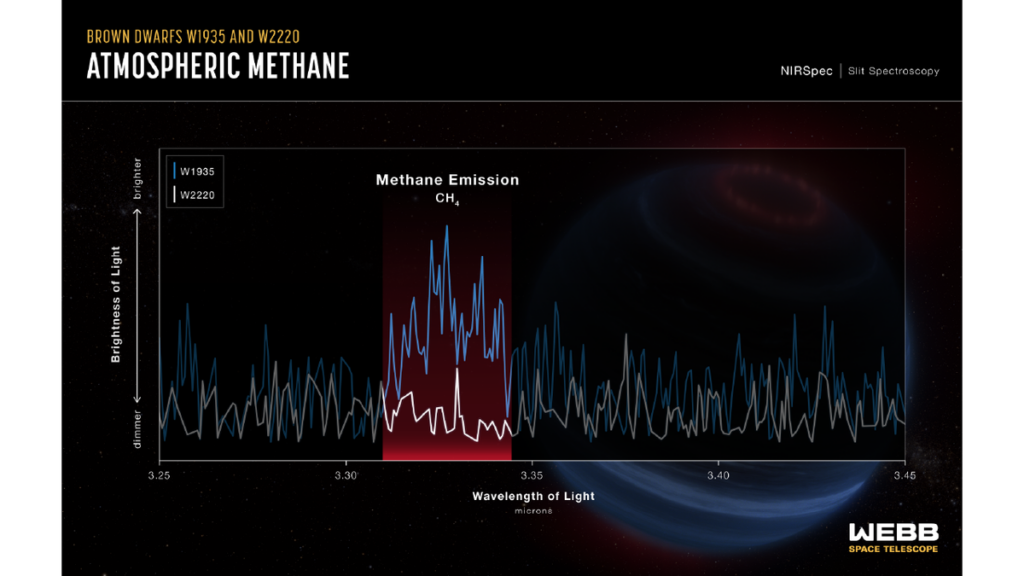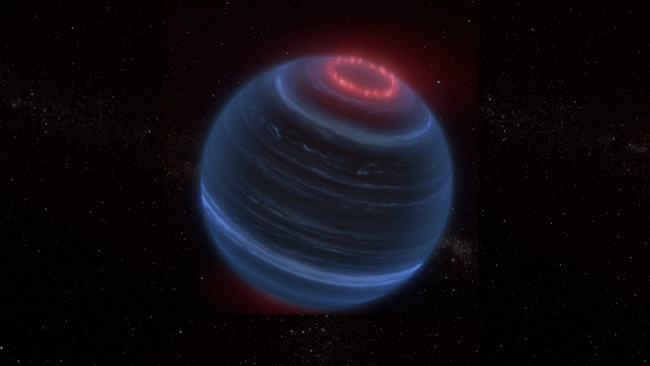The James Webb Space Telescope has detected a subtle indication of an enigmatic aurora above a celestial object categorized as a ‘failed star.
The occurrence of this type of phenomenon has been observed in planets that have a star in close proximity, which can warm up the stratosphere. However, witnessing it in an entity without any apparent external heat source is truly remarkable.
Astronomers have made an intriguing discovery using NASA’s James Webb Space Telescope (JWST). They have observed an aurora around a brown dwarf, often referred to as a “failed star.” Auroras, commonly known as the northern and southern lights, occur when charged particles from the sun interact with molecules in Earth’s atmosphere. Typically, these phenomena are visible at high latitudes due to the magnetosphere directing these particles towards the poles.
Similar auroras have been observed on other celestial bodies in our solar system, including Jupiter, Saturn, and their respective moons, Io and Enceladus. These displays of light are believed to be caused by the bombardment of charged solar particles.
The discovery of an apparent aurora around the brown dwarf, named W1935, located more than 40 light-years away from Earth, is perplexing. There are no nearby stars that could be a source of charged particles to ignite the aurora. Brown dwarfs are larger than gas giant planets but smaller than stars. They form in a manner similar to stars, originating from collapsing clouds of gas and dust. Consequently, most brown dwarfs, like W1935, are often found in isolation, away from other stars.
These “failed stars” earned their nickname because they lack the necessary mass to initiate nuclear fusion of hydrogen into helium at their cores, a process that fuels stars during their main-sequence lifetime.

The detection of infrared emissions from methane by JWST indicated the potential presence of an aurora over W1935. Similar methane emissions observed over Jupiter and Saturn are known to be caused by the heating of their atmospheres due to charged particles traveling along magnetic field lines and colliding with atmospheric particles, resulting in the formation of aurorae. The study team believes that this same mechanism may be responsible for the aurora observed in this isolated brown dwarf.
However, unlike in the case of Jupiter and Saturn where the aurorae are caused by external solar wind, the team suggests that there might be an internal process within the brown dwarf that is supplying energy to its atmosphere. Another possibility is that interstellar plasma is interacting with W1935, or the brown dwarf may not be completely isolated and could be receiving particles from a nearby active moon.
James Webb Space Telescope plays spot the difference with 2 brown dwarfs
The group of scientists, led by Jackie Faherty, an astronomer from the American Museum of Natural History, made a significant discovery during their investigation of 12 brown dwarfs using the JWST.
Within this group, W1935 and W2220 stood out as two remarkably similar brown dwarfs. The $10 billion telescope revealed that these two dwarfs were nearly identical, sharing similar temperatures, brightness, and compositions of water, ammonia, carbon monoxide, and carbon dioxide.
However, there was one notable difference between W1935 and its near twin. W1935 emitted infrared light due to the presence of methane, while W2220 absorbed light because of the same chemical compound.
Faherty expressed her surprise, stating, “We anticipated the presence of methane, as it is commonly found in these brown dwarfs. However, instead of absorbing light, we observed the opposite phenomenon: the methane was actually glowing. My initial reaction was one of confusion. Why was methane emission occurring in this object?”
The team’s discovery of a temperature inversion in the atmosphere of W1935 has left them perplexed. According to Ben Burningham, the research lead modeler from the University of Hertfordshire in England, this phenomenon is typically observed in planets that are in close proximity to a star, which heats up the stratosphere. However, witnessing this in an object without an apparent external heat source is truly remarkable.
To shed light on this puzzling observation, the team turned their attention to Jupiter and Saturn. They found that temperature inversions are also prevalent in the atmospheres of these gas giants within our solar system. The prevailing theory suggests that this inversion is caused by the same process responsible for the creation of auroras.
The unusual characteristics of brown dwarfs, such as radio emissions from warmer examples of these failed stars, have previously been attributed to aurorae. However, the recent observations of W1935 by the JWST have revealed the first-ever detection of methane emission from a brown dwarf, providing evidence of an aurora.
According to Faherty, this discovery of W1935 expands our understanding of a phenomenon within our solar system that does not rely on stellar irradiation for explanation. With the JWST, we now have the opportunity to delve deeper into the chemistry and explore the similarities or differences in the auroral processes beyond our own solar system.
Faherty presented the team’s findings at the 243rd meeting of the American Astronomical Society in New Orleans this week.
This article is republished from SpaceCom under a Creative Commons license. Read the original article.
Do not forget to share your opinion with us to provide you with the best posts !




0 Comments